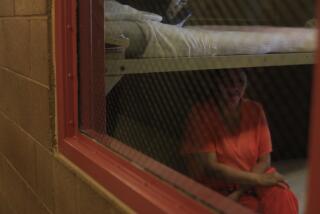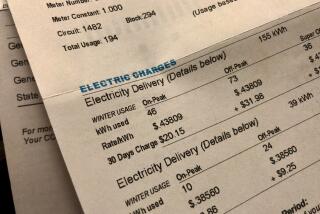SDG&E; Running Hot and Cold on the Sale of Downtown Steam Loop
- Share via
If Richard H. Hertzberg has his way, state-of-the-art buildings being planned for downtown San Diego will use steam--a turn-of-the-century technology--to meet their heating and cooling needs.
For more than 70 years, San Diego Gas & Electric has been operating an underground pipe network that delivers steam to buildings dotting the downtown San Diego horizon. The number of buildings hooked into the steam loop has dropped from 63 to just under 40 in recent years, largely because state regulators have allowed SDG&E; to pass along cost increases to customers.
Prices will continue to rise because the utility probably will gain the state Public Utilities Commission’s permission to continue passing increased costs of operating the system along to steam customers.
The steam loop serves mainly privately owned buildings. However, the U.S. Navy, the City of San Diego and the County of San Diego also buy steam from SDG&E.;
A spokesman for one steam customer said last week that the utility is telling customers that the loop will close at the end of 1988.
Denial on Closing Date
Although the utility denied that a closing date has been set, SDG&E; has told customers that the system “is approaching the time when it is no longer economical to operate,” according to SDG&E; Vice President Gary Cotton.
Hertzberg began negotiating to buy the old steam loop seven months ago, after reading a newspaper article that detailed the utility’s decision to eventually close the loop.
Hertzberg, owner of Enpex, a Sorrento Valley energy company that finances alternative energy projects, believes that the steam loop can be revitalized--if customers want to continue buying steam and if the ancient system’s pipes are in good condition.
Additionally, Hertzberg believes he can deliver steam for about $10 per thousand pounds, far below SDG&E;’s current rate of $24 per thousand pounds. Hertzberg hopes to acquire the pipe system from SDG&E;, install a new, efficient boiler, and turn over the antiquated B Street Power Station to SDG&E.;
SDG&E;, however, recently broke off negotiations with Enpex, citing what Hertzberg described as “legal, regulatory and market reasons.” Hertzberg continues to press the utility for a specific explanation of why negotiations were cut off.
“The utility, for whatever reason, has made a business decision and I can’t fault them,” Hertzberg said in an interview. “So I’m not making them out to be the bad guy in this. But I think the (SDG&E; steam loop) customers will be the real losers if the loop is closed,” Cotton said.
Interest in System
SDG&E; has in the past “met with several entities that have showed interest in the system,” according to Cotton. However, the poor condition of the system’s pipes--which were installed between 1911 and 1921--killed those potential deals, Cotton said.
That doesn’t mean a potential buyer won’t surface, according to industry experts who are familiar with the steam system.
“I would be surprised if one or two of our members haven’t been looking at (acquiring) San Diego’s system,” suggested a spokesman for the International District Heating and Cooling Institute, a Washington, D.C.-based trade group. “It makes economic sense, given the expected (long-term) increase in energy prices.”
SDG&E; is joining a parade of utilities that have abandoned the downtown district heating and cooling business. Only 35 of the 600 districts that were in operation at the turn of the century still exist, according to the institute.
Most of the district heating systems were closed when electric utilities shuttered older, downtown electric generating stations that also produced steam or hot water.
“District heating is small potatoes for investor-owned utilities,” according to one industry spokesman. “They’re in the electric and gas business, not the steam business.”
New Lease on Life
However, steam and hot water systems in a handful of cities, including Pittsburgh and Rochester, recently won new leases on life after steam customers acquired the systems from local utilities and turned them into not-for-profit companies.
District heating proponents argue that utilities generally try to speed the death of district heating systems by painting a very bleak future for the systems.
In Rochester, the local utility sold its system to a group of companies led by Xerox, which owns a 30-story office building in downtown Rochester.
The utility “provided regulators with a lot of evidence to support the non-viability of a buy-out,” according to Xerox spokeswoman Jeanne Boles.
However, the Rochester steam customers eventually banded together to found the nonprofit organization that three years ago began selling steam for about $20 per thousand pounds. “The utility’s price had hit $40 per thousand pounds just before we bought it,” Boles said.
In Pittsburgh, two major department store chains, frustrated by the impending closing of a decades-old steam loop, formed a not-for-profit organization that eventually acquired the steam loop.
“We’ve had some tough times,” acknowledged Bob Wilson, president of the 5-year-old Pittsburgh Allegheny County Thermal Ltd. “But when we bought (the district) the utility’s rates had jumped to $35 per thousand pounds and we started out with rates at $15 per thousand pounds.”
Both Pittsburgh and Rochester now are vying for new business that, in years past, would have gone to the local utility, according to Wilson.
More to Read
Inside the business of entertainment
The Wide Shot brings you news, analysis and insights on everything from streaming wars to production — and what it all means for the future.
You may occasionally receive promotional content from the Los Angeles Times.










